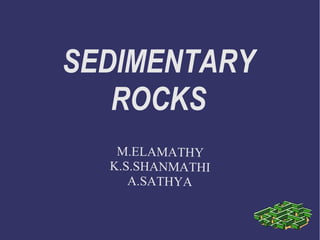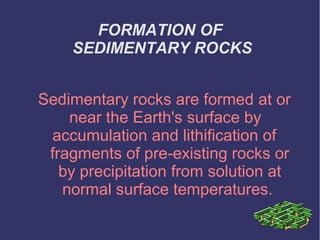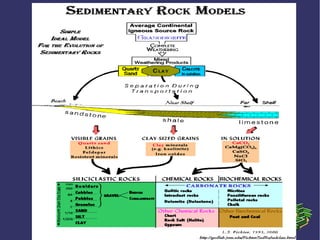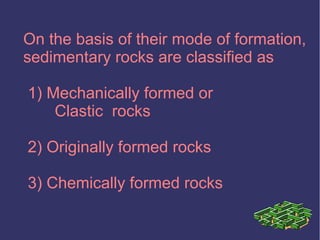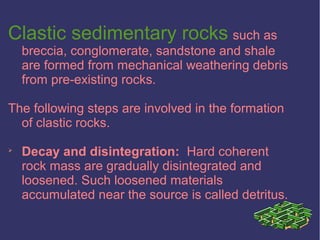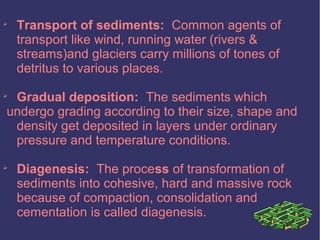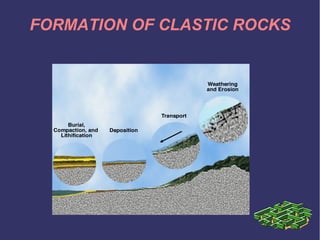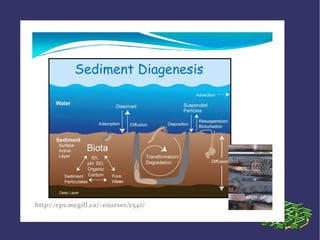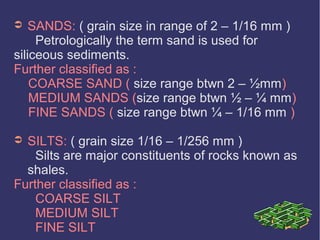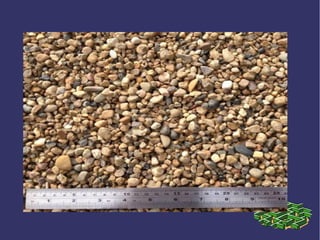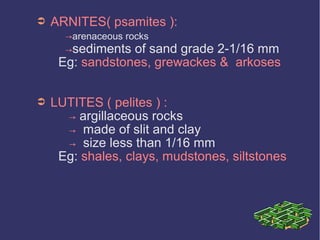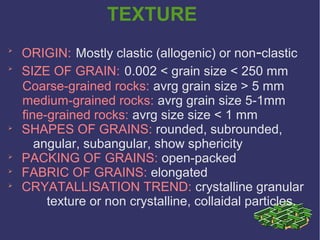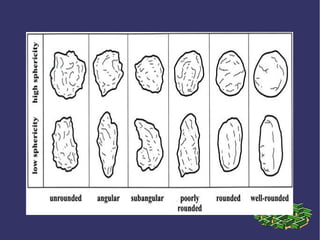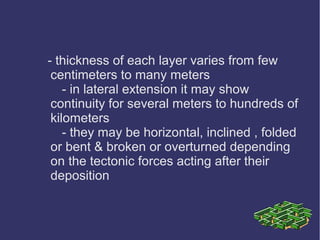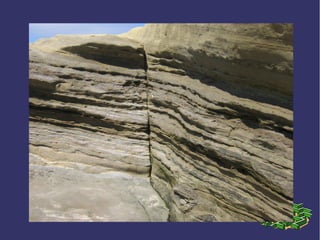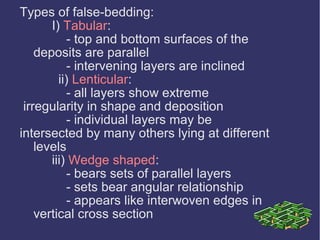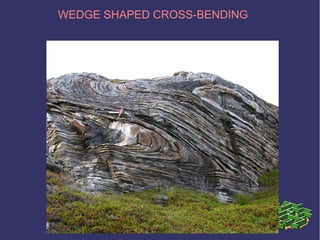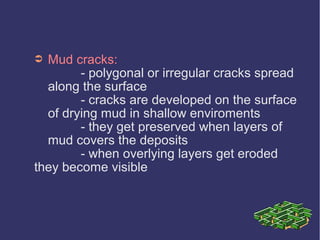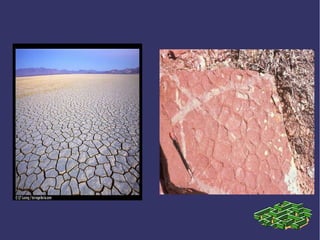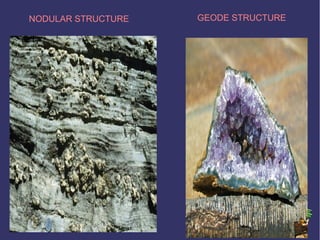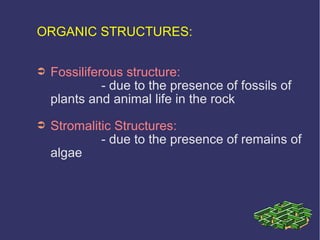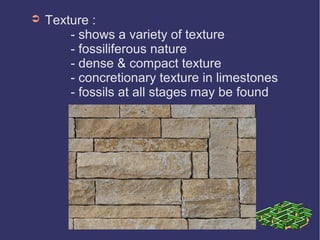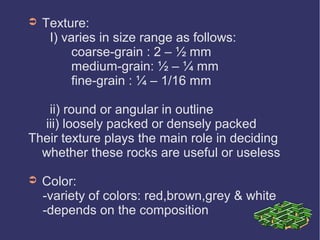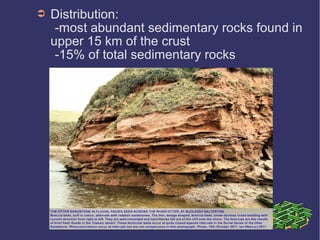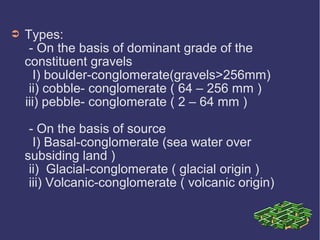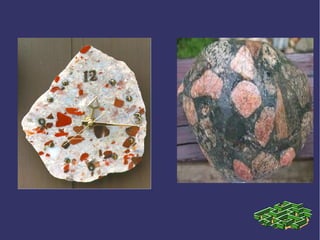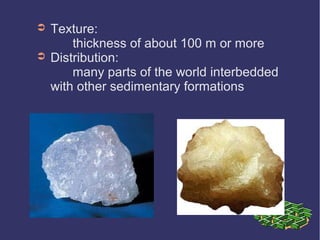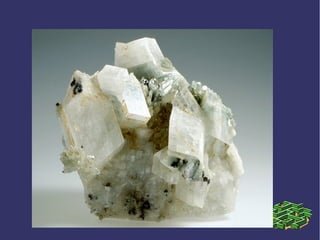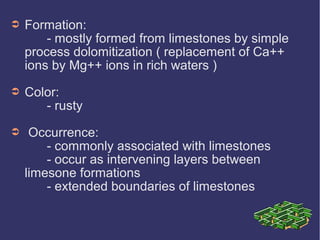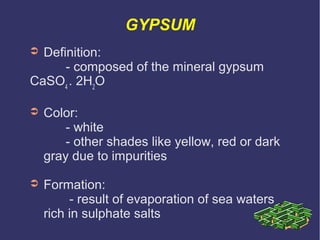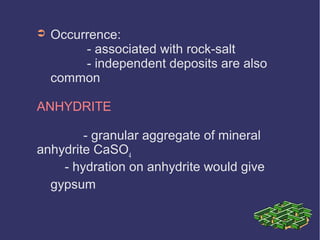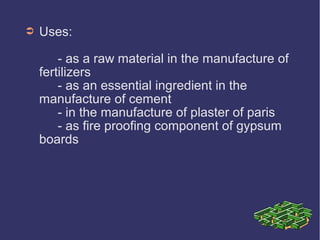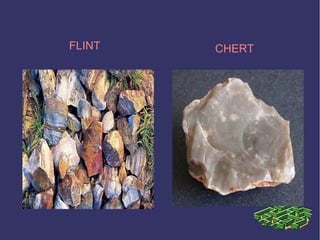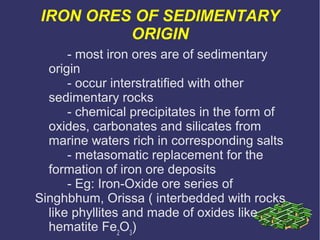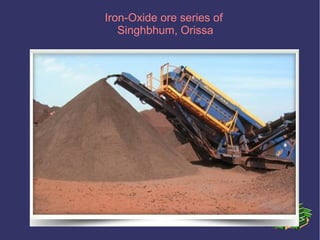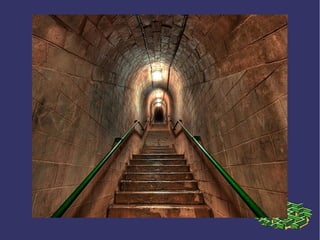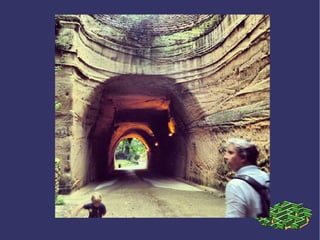Sedimentary rocks
- 2. TOPICS COVERED ➲ INTRODUCTION ➲ FORMATION ➲ CLASSIFICATION ➲ TEXTURES ➲ STRUCTURES ➲ IMPORTANT SEDIMENTARY ROCKS ➲ ENGINEERING IMPORTANCE
- 4. ➲ Sedimentary rocks are the type of rocks that are formed by the deposition of material at earth's surface and within the bodies of rocks. ➲ Contributes about 8% of total volume of crust.
- 5. The study of sedimentary rocks and rock strata provides information about the subsurface that is useful for civil engineering For eg., Construction of roads, houses, tunnels, canals, etc …...
- 6. FORMATION OF SEDIMENTARY ROCKS Sedimentary rocks are formed at or near the Earth's surface by accumulation and lithification of fragments of pre-existing rocks or by precipitation from solution at normal surface temperatures.
- 9. On the basis of their mode of formation, sedimentary rocks are classified as 1) Mechanically formed or Clastic rocks 2) Originally formed rocks 3) Chemically formed rocks
- 10. Clastic sedimentary rocks such as breccia, conglomerate, sandstone and shale are formed from mechanical weathering debris from pre-existing rocks. The following steps are involved in the formation of clastic rocks. Decay and disintegration: Hard coherent rock mass are gradually disintegrated and loosened. Such loosened materials accumulated near the source is called detritus.
- 11. Transport of sediments: Common agents of transport like wind, running water (rivers & streams)and glaciers carry millions of tones of detritus to various places. Gradual deposition: The sediments which undergo grading according to their size, shape and density get deposited in layers under ordinary pressure and temperature conditions. Diagenesis: The process of transformation of sediments into cohesive, hard and massive rock because of compaction, consolidation and cementation is called diagenesis.
- 12. FORMATION OF CLASTIC ROCKS
- 14. Chemical sedimentary rocks such as rock salt,gypsum, anhydrite and some limestones are formed when dissolved materials precipitate from solutions. Organic sedimentary rocks such as coal, and some limestones are formed from the accumulation of plant or animal debris.
- 17. CLASSIFICATION OF SEDIMENTARY ROCKS Based on the average grain size of the sediments Clastic rocks are classified as: ➲GARVEL: (grain size > 2 mm) All sediments and fragments of rocks above size of 2 mm irrespective of composition and shape are called gravels. Further classified as : BOULDERS ( grain size >256mm ) COBBLES ( grain size btwn 256-16 mm) PEBBLES ( grain size <16-2 mm )
- 18. ➲ SANDS: ( grain size in range of 2 – 1/16 mm ) Petrologically the term sand is used for siliceous sediments. Further classified as : COARSE SAND ( size range btwn 2 – ½mm) MEDIUM SANDS (size range btwn ½ – ¼ mm) FINE SANDS ( size range btwn ¼ – 1/16 mm ) ➲ SILTS: ( grain size 1/16 – 1/256 mm ) Silts are major constituents of rocks known as shales. Further classified as : COARSE SILT MEDIUM SILT FINE SILT
- 19. ➲ CLAYS : ( grain size less than in 1/256 mm ) They are formed in variety of ways and abound in nature as soils and rocks as claystone, mudstone, shales, etc.
- 22. TYPES OF CLASTIC ROCKS ( based on grain size)
- 23. ➲ Based on the predominance of sediments, Clastic rocks are divided into : ➲ RUDITES ( psephites) : → rudaceous rocks → average grain size greater than 2mm → made of boulders, cobbles & pebbles Eg : Breccias , conglomerates.
- 24. ➲ ARNITES( psamites ): →arenaceous rocks →sediments of sand grade 2-1/16 mm Eg: sandstones, grewackes & arkoses ➲ LUTITES ( pelites ) : → argillaceous rocks → made of slit and clay → size less than 1/16 mm Eg: shales, clays, mudstones, siltstones
- 25. TEXTURE ORIGIN: Mostly clastic (allogenic) or non-clastic SIZE OF GRAIN: 0.002 < grain size < 250 mm Coarse-grained rocks: avrg grain size > 5 mm medium-grained rocks: avrg grain size 5-1mm fine-grained rocks: avrg size size < 1 mm SHAPES OF GRAINS: rounded, subrounded, angular, subangular, show sphericity PACKING OF GRAINS: open-packed FABRIC OF GRAINS: elongated CRYATALLISATION TREND: crystalline granular texture or non crystalline, collaidal particles.
- 27. STRUCTURES MECHANICAL STRUCTURE: - most prevalent structure in sedimentary rocks - developed due to physical processes at the time formation of the rocks ➲ Stratification: - layered arrangement in a sedimentary rock - strata may be similar or dissimilar in color, composition, grain size & texture. - bedding planes may separate the strata from each other
- 28. - thickness of each layer varies from few centimeters to many meters - in lateral extension it may show continuity for several meters to hundreds of kilometers - they may be horizontal, inclined , folded or bent & broken or overturned depending on the tectonic forces acting after their deposition
- 31. ➲ Lamination: - layered structure - individual layers(laminae) are thinner(less than 1 cm ) - characteristic structure of clays & shales ➲ Cros Bending: - layers lying one above other are not parallel - irregular or inclined relationship - deposition in shallow waters - stream suffers repeated change in direction of flow - false-bedding or current bedding
- 32. Types of false-bedding: I) Tabular: - top and bottom surfaces of the deposits are parallel - intervening layers are inclined ii) Lenticular: - all layers show extreme irregularity in shape and deposition - individual layers may be intersected by many others lying at different levels iii) Wedge shaped: - bears sets of parallel layers - sets bear angular relationship - appears like interwoven edges in vertical cross section
- 37. ➲ Graded bedding: - component sediment in each layer appear to be characteristically sorted and arranged according to their grain size , coarsest at the bottom and finest at the top - result of sedimentation in standing water by gravitative settling or subaqeous landslides or submarine earthquakes
- 38. ➲ Mud cracks: - polygonal or irregular cracks spread along the surface - cracks are developed on the surface of drying mud in shallow enviroments - they get preserved when layers of mud covers the deposits - when overlying layers get eroded they become visible
- 40. ➲ Rain Prints: - irregular , small crater-shaped depressions seen on fine-grained dried sediments - rain falling on fine-grained compacted clays form crater like depressions - these get dried up and preserved under another layer of mud
- 41. ➲ Ripple Marks: - deposits made in shallow water - symmetrical asymmetrical, wave- like irregularity in a layer - due to wind action or wave action during deposition
- 42. ➲ Mud cracks, rain prints, ripple marks are the confirmatory evidence for the formation of deposits in shallow water environment.
- 43. CHEMICAL STRUCTURE: ➲ Concretionary Structure: - made up of concretions of various shapes and dimensions - individual concretions may be rounded, sub-rounded, rough or smooth and small - examples : oolitic & pisolitic In OOLITIC structures, concretions are of the size of fish eggs( 0.1 – 1 mm ). Appears like assemblage of fish-eggs In PISOLITIC structures, concretions are of peanut size . Eg: limestones, bauxite
- 44. ➲ Nodular Structures: - irregularly shaped nodules of chert, iron oxides, iron carbonates, clayey ironstones - nodules show elongation or flattening parallel to bedding planes ➲ Geode Structures: - hollow shell of rock - interior is lined with inwardly projecting crystals - rock shell is made up of chalcedony & inner encrustations are made up of quartz crystals
- 45. OOLITIC CONCRETIONARY PISOLITIC CONCRETIONARY
- 46. NODULAR STRUCTURE GEODE STRUCTURE
- 47. ORGANIC STRUCTURES: ➲ Fossiliferous structure: - due to the presence of fossils of plants and animal life in the rock ➲ Stromalitic Structures: - due to the presence of remains of algae
- 48. FOSSILIFEROUS STRUCTURE STROMALITIC STRUCTURE
- 49. IMPORTANT SEDIMENTARY ROCKS LIMESTONES ➲ Definition: -most common non-clastic sedimentary rocks ➲ Composition: calcite ( CaCO3 ),dolomite ( CaMg(CO3 )), quartz ( SiO2 ) , felspar minerals and iron oxides. Chemically CaO, CO2 , MgO.
- 50. ➲ Texture : - shows a variety of texture - fossiliferous nature - dense & compact texture - concretionary texture in limestones - fossils at all stages may be found
- 51. ➲ Types : -autochthonous : formed by biogenic precipitations fron seawaters -allochthonous : formed from precipitated calcareous sediments Common types are chalk, shelly limestone, argillaceous limesone, lithographic limestone, kankar, calc-sinter ➲ Formation: purely organic or in-organic origin
- 52. Environments of formation: ➲ Biothermal limestones: -occur in the form of reefs or mounds transferred to corals -highly fossiliferous ➲ Biostromal limestones: sheet-like accumulations of biogenic deposits ➲ Pelagic limestones: formed from limy secretion of floating type of sea organisms
- 53. ➲ Uses: I) important application in industries and engineering practices ii) it is the primary source material for portland cement iii) in metallurgical industries as flux iv) construction practice as building and road stones v) chemical industries ➲ Occurences: occurs as mountains and hills
- 57. OCCURENCE
- 58. SANDSTONES ➲ Definition: -mechanically formed sedimentary rocks of Arenaceous group. -Silica in the form of Quartz is the dominant mineral constituent of most sandstones ➲ Composition: -quartz ( SiO2 ), felspar, micas, garnet, magnetite
- 59. ➲ Texture: I) varies in size range as follows: coarse-grain : 2 – ½ mm medium-grain: ½ – ¼ mm fine-grain : ¼ – 1/16 mm ii) round or angular in outline iii) loosely packed or densely packed Their texture plays the main role in deciding whether these rocks are useful or useless ➲ Color: -variety of colors: red,brown,grey & white -depends on the composition
- 60. ➲ Types: -Based on the composition and nature of cementing material the following types are identified I) Siliceous sandstones ii) Calcareous sandstones iii) Argillaceous sandstones iv) Ferruginous sandstones -Based on the minerological composition sandstones are grouped as Arkose, reyeacke, Flagstone, Freestone, Ganister
- 63. ➲ Uses: I) building stones, pavement stones & road stones ii) redfort of india is made up of sandstones
- 66. ➲ Distribution: -most abundant sedimentary rocks found in upper 15 km of the crust -15% of total sedimentary rocks
- 67. CONGLOMERATES ➲ Defiinition: - clastic nature - rudaceous group - has rounded fragments - roundness indicates the constituent garvels were transported to some distance ➲ Composition: - heterogeneous mixture - no definite composition - has clasts of any rock material or weathering products washed downstream
- 69. ➲ Types: - On the basis of dominant grade of the constituent gravels I) boulder-conglomerate(gravels>256mm) ii) cobble- conglomerate ( 64 – 256 mm ) iii) pebble- conglomerate ( 2 – 64 mm ) - On the basis of source I) Basal-conglomerate (sea water over subsiding land ) ii) Glacial-conglomerate ( glacial origin ) iii) Volcanic-conglomerate ( volcanic origin)
- 70. - On the lithological basis I) Oligomictic ( simple in composition ) ii) Polymictic ( derived from rocks of all sorts ) ➲ Texture: - matrix supported rocks - contains 15% sand sized or smaller grains and the rest larger grains of various size
- 72. ➲ Color: - many different colors - base color of brown, black or grey - rock fragments embedded on them may vary in size, shape & color ➲ Significance: - special geological significance when they occur in the form of well-defined layers of good thickness - indicative of shallow water phase in the depositional environment ➲ Uses: - decoration - in construction industry
- 74. ROCK SALT ➲ Composition: mineral halite (NaCl) ➲ Texture: varies from coarse-grained massive ➲ Color: white in purest form greyish or reddish in impure state ➲ Formation: evaporation of concentrated saline seawater subsidence of the basin of deposition during the process of evaporation
- 75. ➲ Texture: thickness of about 100 m or more ➲ Distribution: many parts of the world interbedded with other sedimentary formations
- 76. DOLOMITE ➲ Definition: - carbonate rock of sedimentary origin - made up of the mineral dolomite CaMg(CO3 )2 - ferrous iron may also be present ➲ Texture: - coarsely crystalline, finely crystalline or interlocking crystals - rhombohedral habit
- 79. ➲ Formation: - mostly formed from limestones by simple process dolomitization ( replacement of Ca++ ions by Mg++ ions in rich waters ) ➲ Color: - rusty ➲ Occurrence: - commonly associated with limestones - occur as intervening layers between limesone formations - extended boundaries of limestones
- 80. GYPSUM ➲ Definition: - composed of the mineral gypsum CaSO4 . 2H2 O ➲ Color: - white - other shades like yellow, red or dark gray due to impurities ➲ Formation: - result of evaporation of sea waters rich in sulphate salts
- 81. ➲ Occurrence: - associated with rock-salt - independent deposits are also common ANHYDRITE - granular aggregate of mineral anhydrite CaSO4 - hydration on anhydrite would give gypsum
- 82. ANHYDRITE
- 83. ➲ Uses: - as a raw material in the manufacture of fertilizers - as an essential ingredient in the manufacture of cement - in the manufacture of plaster of paris - as fire proofing component of gypsum boards
- 85. FLINT AND CHERT ➲ FLINT: - dark colored sedimentary rock of siliceous composition - consists mainly of chalcedony and fine- grained quartz - occurs commonly as concretions or nodules in chalk (limestone) deposits ➲ CHERT: - composed of cryptocrystalline silica - variety of colors - occurs as beds or layers within limestones and other ddeposits
- 86. FLINT CHERT
- 87. - sedimentary rock of glacial origin - structureless matrix that has fragments of various sizes, shapes and composition - bears striations indicating their transportation from glaciers - compacted and consolidated form of glacial debris called till - matrix or ground mass is of gray or greenish - embedded fragments are extremely heterogeneous TILLITE
- 89. IRON ORES OF SEDIMENTARY ORIGIN - most iron ores are of sedimentary origin - occur interstratified with other sedimentary rocks - chemical precipitates in the form of oxides, carbonates and silicates from marine waters rich in corresponding salts - metasomatic replacement for the formation of iron ore deposits - Eg: Iron-Oxide ore series of Singhbhum, Orissa ( interbedded with rocks like phyllites and made of oxides like hematite Fe2 O3 )
- 90. Iron-Oxide ore series of Singhbhum, Orissa
- 91. ENGINEERING IMPORTANCE ➲ Covers a great part of the earth's crust ( 75% of surface land mass) ➲ Withstand loads under heavy construction ➲ Natural reservoirs of oil and ground water supplies ➲ They may be used in cuts and tunnels in highway construction and also as reservoirs
- 95. THE END
